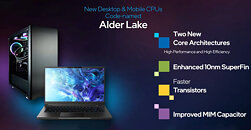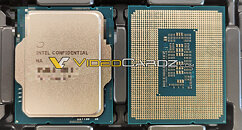Sunday, January 24th 2021

Intel "Alder Lake-S" Due for September 2021
2021 is shaping up to be a big year for Intel in the DIY desktop space, with the company preparing to launch not one, but two generations of desktop processors. Having announced them in January, the 11th Gen Core "Rocket Lake-S" desktop processors in the LGA1200 package, will release to market in March, with the company claiming a restoration in gaming performance leadership away from AMD's Ryzen 5000 series. Sources tell Uniko's Hardware that the company will announce its 12th Gen successor, the Core "Alder Lake-S" in September 2021.
"Alder Lake-S" will be Intel's first mainstream desktop processor built on its new 10 nm SuperFin silicon fabrication process. The chip is expected to be a "hybrid" processor, combining an equal number of larger "Golden Cove" cores, and smaller "Gracemont" cores, to offer significantly improved energy efficiency. Built in the new Socket LGA1700 package, "Alder Lake-S" is expected to feature more general-purpose SoC connectivity than LGA1200 chips. It will also herald new platform standards, such as DDR5 memory and possibly even mainstreaming of ATX12VO. The processor will launch alongside new Intel 600-series chipset. AMD's response is expected to be the "Zen 4" microarchitecture, a new silicon built on the 5 nm process, and the new AM5 socket that introduces DDR5 memory support.
Sources:
Uniko's Hardware, Videocardz
"Alder Lake-S" will be Intel's first mainstream desktop processor built on its new 10 nm SuperFin silicon fabrication process. The chip is expected to be a "hybrid" processor, combining an equal number of larger "Golden Cove" cores, and smaller "Gracemont" cores, to offer significantly improved energy efficiency. Built in the new Socket LGA1700 package, "Alder Lake-S" is expected to feature more general-purpose SoC connectivity than LGA1200 chips. It will also herald new platform standards, such as DDR5 memory and possibly even mainstreaming of ATX12VO. The processor will launch alongside new Intel 600-series chipset. AMD's response is expected to be the "Zen 4" microarchitecture, a new silicon built on the 5 nm process, and the new AM5 socket that introduces DDR5 memory support.


75 Comments on Intel "Alder Lake-S" Due for September 2021
What I see right now though, is that it's significantly cheaper and far easier to buy a prebuilt, whether that comes from big OEMs like Dell / HP etc or smaller SI's like CyberPowerPC or iBuyPower. The SI's tend to give better prices, but the OEMs have better warranties.
This is new though, I built my own back in June for less than a prebuilt of similar spec and quality. I've tried recently to spec out a prebuilt and can't really beat SI / OEM prices right now, at least not with one of the new GPUs.Laptops accelerated from 65% of the market in 2019 to 75% in 2020. I think the effect is that fewer resources are pushed into the desktop space in general from all the players. Notice how easy it is right now to get a laptop with a 3060 or 3070, and Tiger Lake H.
From a supplier's standpoint, it's a lot easier and cheaper for a supplier to send all their kit to a few big OEMs. Sign contract with OEM - we will supply you with 50,000 video cards per month delivered here by Xth of the month. Easy and straight to the point, no ambiguity as to what needs to be done. But to that same supplier the DIY market looks more like, keeping inventory on hand in a warehouse to supply 100 different retailers with potentially 10,000 different locations with 5-10 GPUs on demand.
Some people with 2-3 year+ upgrade cycle might just want to invest to RL with guaranteed system stability/compatibility also cheaper components and wait till next gen platform matured enough also cheaper enough.
Don’t need 250 watt arc welder either.
Alder Lake will get a shot.
I don't see any sabotaging happening
I hope you're right about the complete systems sabotage not happening, or us PC enthusiasts are up Schitt Creek.
You are still only getting 8 high performance cores. And I fear the core management might be a complete mess for a while. Like how will apps/games know which cores to utilize? Has it not been proven, that unconventional architectures are not right for desktops? Bulldozer? Even the CCX approach in first Zen CPUs was not great.
10 nm also does not necessarily mean better. Will these CPUs reach high clock speeds? Process maturity is way more important than power consumption in that respect. Remember Broadwell?
Also, DDR5 will be slower and more expensive for the first few years, just as it always is. It will start to make sense when you can get 4800+ modules for the same price you can get 3200 modules now, and those are super cheap. Even 3600 CL16 is cheap.
Rocket Lake actually gets all the bells and whistles. 8 high performance cores with high clock speeds, PCI-E 4.0 for GPU, as well as on-die Gen4 NVMe link. Plus two times faster DMI resulting in more M.2 slots and native USB 20 Gbps support.
This platform literally has everything you will possibly need for 3-4 years. No quirks to work out, no problems, "it just works".
If you need more cores, go for Zen 3. Waiting for Alder Lake seems pointless. Rocket Lake will be the way to go if you want to stick with Intel.
I have no idea either how the big.little approach helps the desktop and by the sound of it, there's not much documentation on it, hence others don't know either. What I do know, is that Intel wouldn't invest lots of dollars in developing it if there wasn't a benefit.
Looks pretty good vs 10700k, so, why?
It will not be easer until 2023:
www.theregister.com/2021/04/16/tsmc_chip_forecast/
big.LITTLE is better suited for laptops, where power efficiency is king, not desktops, where (unless Intel fails at getting heat out of their die) it doesn't really matter since you can customize your cooler.
Side note, does anyone else see the irony in big.LITTLE?
And then with (maybe) Zen 5 we'll have AMD big.LITTLE chips.
I hope they make some big.LITTLE and some not, so like the Ryzen 5 7500 BL (big.LITTLE), 7500 BLX (big.little X version), and so on.
We simply need all cores at a stable speed, preferably 4GHz.
Intel lost out from not having a fast enough reply to AMD Zen.
Just adding more cores/heat and fancy marketing slogans isn’t going to work.
At least they admit 2023 will be the year they get back on track.
It should actually be helpful in all core workloads as well. Maybe equivalent to 12 big cores with 24 threads?